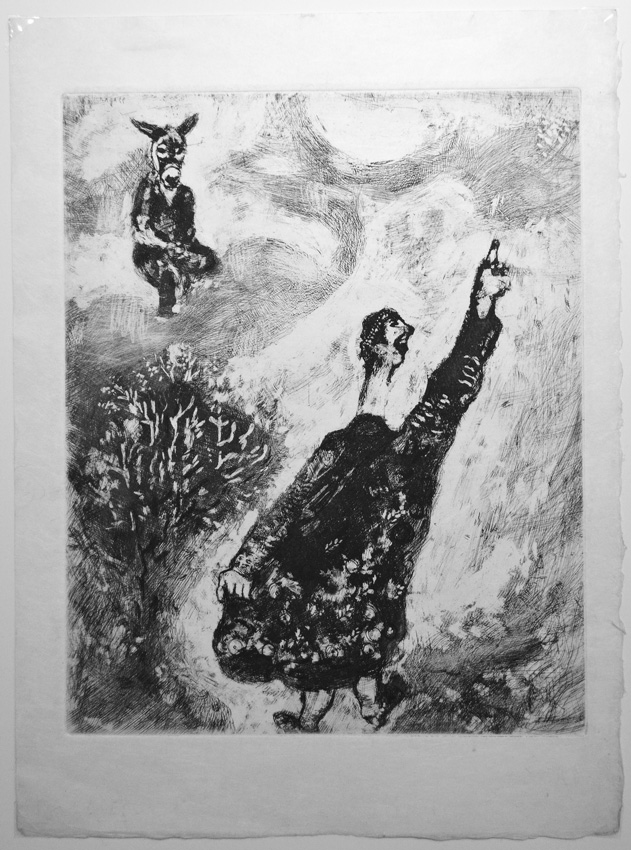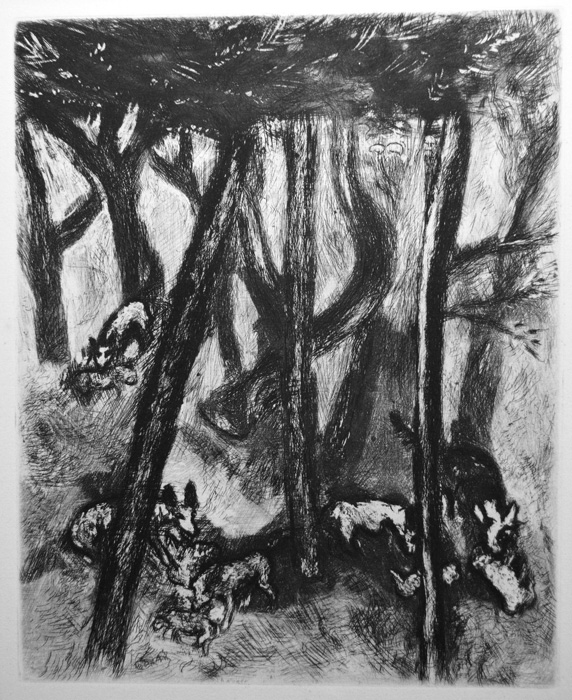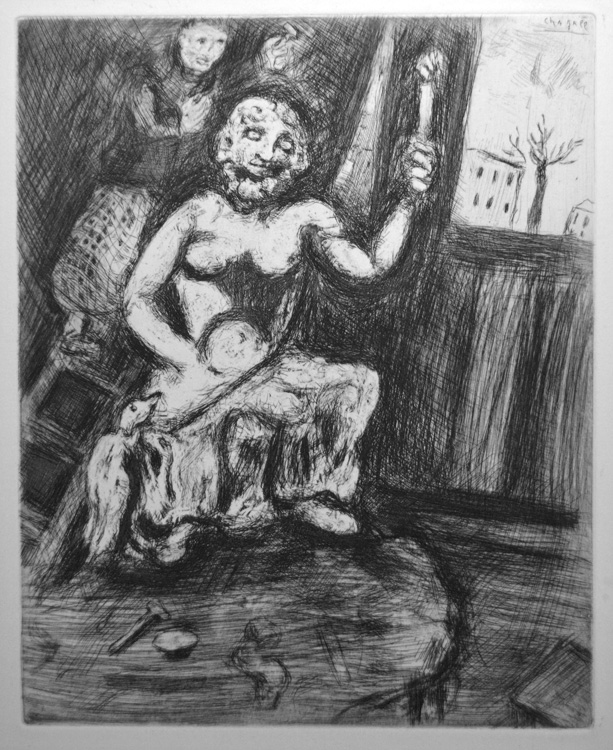Click image for BBB rating
See our Privacy Policy
cool="cool" width="817" height="7214" border="0" cellpadding="0" cellspacing="0" gridx="16" showgridx="showgridx" usegridx="usegridx" gridy="16" showgridy="showgridy" usegridy="usegridy" bgcolor="#99ccff">
|
|
|
 |
|
|
|
|
|
|
Welcome to Spaightwood Galleries, Inc.
120 Main Street, Upton MA 01568-6193; 800-809-3343
|
|
|
|
|
In 1927, Chagall began working on another project for Vollard, a series of etchings illustrating The Fables of La Fontaine. In these plates we move from the fantastic Russia of Chagall’s imagination and memory to the more dream-like world of ancient myth and fable, told and retold, changing from time to time and place to place, but ultimately always the same. Technically these works differ greatly from those of the Dead Souls. As Meyer comments, "Compared with the last sheets for Dead Souls, in the new plates the painterly content appears enormously increased. Chagall now foregoes the application of aquatint and use of the rocking tool; also dry point technique is scarcely evident. Instead, he does everything by means of etching, and covers the engraved surface with stopping out varnish, a combination that makes for intensive painterly effects. The etching needle draws the most delicately ramified foliage and bush patterns, the texture of plumage and soft fur, and through shadings and cross-hatchings gives a range of tonalities . . . from white to a deep black. . . . Thus each picture is the result of a long series of working stages in the course of which the pictorial design in light and dark is slowly worked out in a process comparable to the building up of the color structure in a painting." One of our etchings tells the story of the wanderer who was welcomed into the cave of a family of satyrs. After watching him first blow upon his hands to warm them and then upon his soup to cool it, the satyrs become fearful and ask him to leave, deciding that there is no trusting a man who can blow both hot and cold. In the other, a fox and a goat leap into a well together then find they cannnot get out. The fox suggests that the goat let him climb up its back and then out of the well, promissing to pull the goat up after he is free. The goat agrees, only to be lectured by the fox on the stupidity about jumping into wells out of which one cannot climb. The moral is "better think of the outcome before you begin."
The etchings for The Fables were executed by Chagall between 1927 and 1930; The Fables was issued in an edition of 200 portfolios on Montval, 40 of which also contained a suite of the etchings on japon nacre and 85 of which contained a suite with hand coloring. In addition, there were 15 portfolios hors commerce. There were also 100 sets of the etchings only on paper with wide margins, each of which was signed and numbered.
|
|
|
|
|
|
|
|
 |
|
|
Les Grenouilles qui demandent un Roi / The Frogs who asked for a King (Fables plate 34, Hannover 176, Sorlier 123). Original etching, 1923-1927. 100 pencil-signed impressions, 85 hand-colored impressions, and 240 impressions (of which 40 are on japon paper) signed in the plate lower right for The Fables of La Fontaine. Tired of democracy in their swamp, the frogs asked Jupiter for a king. Tired of their croaking, Jupiter dropped down in dead tree, a "king not in the least bit harsh / But whose arrival caused such panic in the marsh / That all that popeyed population, / A cowardly and stupid nation, / Dived in the water, hid in the weeds, / Sank into holes, shrank among the reeds." Upon discovering that their new ruler was completely passive, the frogs demanded a proper ruler, "a king who gets things done." Tired of their complaining, Jupiter sent a crane, "Who speared them, who crunched them, / Who gobbled them, who munched them / On arbitrary grounds." When the frogs complain again, Jupiter responds that they could have lived in "the benevolent control / Of that sweet-natured figurehead I sent. / So now fall silent and accept your curse, / For fear you'll go from bad to worse" (Craig Hill, trans., The Complete Fables of La Fontaine (NY: Arcade Publishing, 2008), pp. 56-57. A very sharp impression with an expertly-repaired paper loss in the lower left corner just outside the platemark at the corner; otherwise, full margins. Image size: 295x236mm. Mat size: 16x20. Price: Please call or email for current pricing information.
|
|
|
 |
|
|
|
|
L'Ivroigne et sa Femme / The drunkard and his wife (H. 179, S. 166). Original etching, 1927-30. 100 pencil-signed impressions, 85 hand-colored impressions, and 240 impressions (of which 40 are on japon paper) signed in the plate for The Fables of La Fontaine. The suffering wife is shown with the wings of an angel. Ours is a brilliant impression on Japon paper. Remains of old hinges on the reverse. Image size: 296x238mm. Price: Please call or email for current pricing information.
|
|
|
|
 |
|
The satyr and the wanderer (H. 203, S. 151). Original etching, 1927-30. 100 pencil-signed impressions, 85 hand-colored impressions, and 240 impressions (of which 40 are on japon paper) signed in the plate for The Fables of La Fontaine. Ours is a brilliant impression on Japon.The Satyr invites a traveller into his home. He sees him blow on his hands, asks why, and is told that he does it to warm his hands. He sees him blow on his soup, inquires, and is told he does it to cool the soup. The satyr then asks him to leave, saying he cannot trust anyone who can blow both hot and cold. Image size: 296x238mm. Price: Please call or email for current pricing information.
|
|
|
|
|
|
|
 |
|
"Le Charlatan" / The Charlatan (H. 217, S. 165). Original etching, 1927-1930. 100 pencil-signed impressions, 85 hand-colored impressions, and 240 impressions (of which 40 are on japon paper) signed in the plate for The Fables of La Fontaine. Ours is a very rich impression. A charlatan boasts that he can teach any ass (whether figurative or literally) to be eloquent. The king makes a deal: in 10 years, if he cannot teach an ass to speak eloquently on any subject, the king gets to cut off his head. The charlatan agrees. When a courtier wonders how he could have entered into this bet which he cannot win, the charlatan responds, "Long before then, the king, the ass, or I most likely will have died"; in the meantime he gets to live the good life at the king's expense. Moral: sometimes taking dumb risks can pay off; sometimes, you could end up with your head hanging from a noose. Images size: 298x241mm. Price: Please call or email for current pricing information.
|
|
 |
|
|
Le Fou qui vend la Sagesse / The fool who peddles wisdom (H. 237, S. 185). Original etching, 1927-30. 100 pencil-signed impressions, 85 hand-colored impressions, and 240 impressions (of which 40 are on japon paper) signed in the plate for The Fables of La Fontaine. Ours is a brilliant impression on Japon paper. Once again, foolishness becomes the topic of the Fable: the fool who sells wisdom respponds to his buyers by first giving them a "swat on the ear and a thread–in length, two paces. / Most got angry–but anyone who thought / About it might have seeen that this made them appear / In a worse light yet." A sage replies to one of the fool's victimes, "These things are hieroglyphics, simple ones to solve. / All those who hope to prosper would do well to place / Between themselves and fools a space / Which this thread measures. If they do not, / They will receive a similar swat. / You weren't cheated. The fool sold wisdon–which you got." Image size: 294x237mm. Price: Please call or email for current pricing information.
|
|
|
|
|
|
 |
|
The fox and the ram (H. 177, S. 124). Original etching, 1927-30. 100 signed & numbered impressions, 85 hand-colored impressions, and 240 impressions (of which 40 are on Japon paper) signed in the plate lower left for "The Fables of La Fontaine Ours is an impression on Rives; slight staining lower right corner not affecting image. In early literature, foxes are always tricksters, and this fox is no different. The fox and the ram go for a a ramble, the ram never giving a thought to where they are going. Seeing a well, they jump in because they are thirsty, but once in they cannot climb out. The fox tells the ram to stand up straight against the wall so they fox can run up his back: "using you as a scaffold, I / in no time will be gone bye bye–though not, of course, before I pull you out." / "Upon my beard," the goat replied, "that's very smart! / God, how I love to hang out with intellectuals like you." Once out, of course, the fox runs off, but not before he gives a little "sermon" to console the ram, the gist of which is, think before you act: "Before you go in, think long and hard about / How you'll get out." Illustrated Nice 1987. Image size: 297x241mm. Price: Please call or email for current pricing information.
|
|
|
|
|
 |
|
Marc Chagall, "Les loups et les brebis" / The wolves and the sheep. (H. 183, S. 130). Original etching, 1927-30. Plate 37 of "The Fables of La Fontaine," commissioned by Vollard after Chagall completed the etchings for "Dead Souls." 100 pencil-signed impressions, 85 hand--colored impressions, and 240 impressions (of which 40 are on Japon paper) signed in the plate for "The Fables of La Fontaine." Ours is an impression on Rives. Watermark: C with nude inside it. The wolves and the sheep declare a truce and each gives babies as hostages to the other to secure it. All is well until the wolf cubs grow up and slaughter all the lambs, joined in the slaughter of the sheep by their elders. THe moral? "One must / War constantly against the cruel and unjust. / Peace in itself is good, its value is immense, / But what can be the sense / Of peace with an enemy whom one can never trust?" Signed in the plate at the bottom margin left of center. Image size: 294x240mm. Price: Please call or email for current pricing information.
|
|
|
|
|
 |
|
Le statuaires et la statue de Jupiter / The sculptor and the statue of Jupiter (H. 235, S. 183) Original etching, 1927-30. Plate 89 of The Fables of La Fontaine, commissioned by Vollard after Chagall completed the etchings for Dead Souls. 100 pencil signed impressions, 85 impressions hand-colored by Chagall, and 240 impressions (of which 40 are on japon paper) signed in the plate for The Fables of La Fontaine. Ours is an impression on Rives. Printer's ink at margin, upper center, not affecting image. Image size: 296x237mm. Price: Please call or email for current pricing information.
|
|
|
|
 |
|
Le chameau et les bâtons flottants / THe camel and the floating sticks (H. 190, S. 134) Original etching, 1927-30 Plate 44 of The Fables of La Fontaine, commissioned by Vollard after Chagall completed the etchings for Dead Souls. 100 pencil signed impressions, 85 impressions hand-colored by Chagall, and 240 impressions (of which 40 are on japon paper) signed in the plate upper left for The Fables of La Fontaine. Ours is an impression on Rives. Image size: 298x238mm. Price: Please call or email for current pricing information.
|
|
|
|
|
|
 |
|
Le chat et les deux Moineaux / The cat and the two sparrows (H. 243, S. 191). Original etching, 1927-30. 100 pencil signed impressions (of which this is one), 85 hand-colored impressions, and 240 impressions (of which 40 are on japon paper) signed in the plate for The Fables of La Fontaine. This image occurs as plate 97 in the Fables. The Fable concerns a cat and a sparrow whohave been brought up together and become friends. They play with each other and scuffle playfully at times, but the cat always keeps his claws in. One day a strange sparrow flies in and assaults the cat's friend. The cat, defending the honor of his sparrow, proceeds to kill and eat the stranger. However, having tasted sparrow tartare, so to speak, his friend soon follws the stranger down the cat's throat as he reflects, "The world is right! / A bird is certainly a bite upon which to gloat." The poet offers the dedicatee, the Duke of Burgundy, the opportunity to draw his own moral from this fable: "What moral can I deduce from what has just been said? / Fables aren't fables if not brought to a head. / I seem to detect outlines which escape me; no use; / Conundrums are for you, not for my groping muse." Since the Duke does not reply, it is up to readers to supply the missing moral. A very strong impression; slight discoloration outside the platemark. Image size: 299x237mm. Price: Please call or email for current pricing information
|
|
|
|
|
Spaightwood Galleries, Inc.
To purchase, call us at 1-800-809-3343 (1-508-529-2511 in Upton MA & vicinity) or send an email to spaightwood@gmail.com.
We accept AmericanExpress, DiscoverCard, MasterCard, and Visa.
We also accept wire transfers and paypal.
For directions and visiting information, please call. We are, of course, always available over the web and by telephone (see above for contact information). Click the following for links to past shows and artists. For a visual tour of the gallery, please click here. For information about Andy Weiner and Sonja Hansard-Weiner, please click here. For a list of special offers currently available, see Specials.
Go back to the top of this page.
Visiting hours: Saturday 10:00 am to 5:00 pm and Sunday noon to 6:00 pm and other times by arrangement.
Please call to confirm your visit. Browsers and guests are welcome.
|
|
|
|
|
|
|
|
|
|
|
|
|
|
|
|
|
|
|
|
|
|
|
|
|
|
|
|
|
|
|









